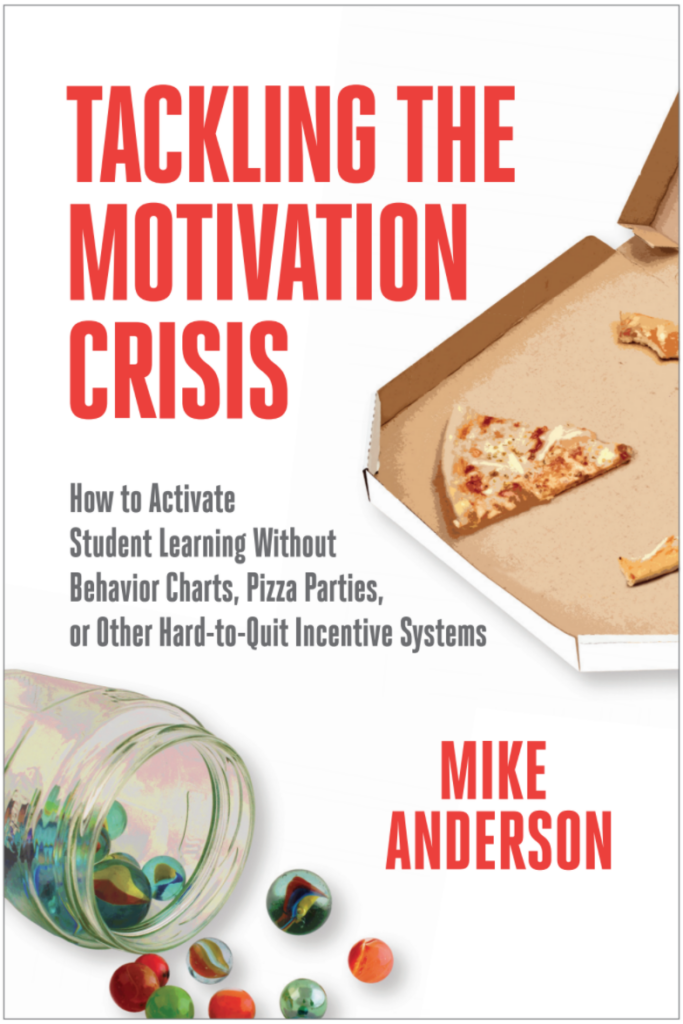The Factory Model of Schooling
A Brief History of Behaviorism, Part 4
If you could travel back in time about 60 years and walk through a typical school, you might be surprised to find something missing. You wouldn’t see behavior charts or “star student” award posters. You wouldn’t see teachers handing out “cougar bucks” to children walking quietly in hallways or kids being promised pizza if they worked hard during math time. Token economy systems like these hadn’t yet been invented. Have you ever wondered, where did these systems come from?
While writing Tackling the Motivation Crisis: How to Activate Student Learning Without Behavior Charts, Pizza Parties, or Other Hard-to-Quit Incentive Systems, I researched behaviorism, the branch of psychology that birthed these systems. What I learned was fascinating, and it helped me better understand where these incentives systems that are so common (and damaging, by the way) came from. I’m excited to share some of what I learned in this series of blog posts. Enjoy!
The Factory Model of Schooling
As behaviorism was in its infancy, so too was the model of public schools. In The End of Average: How We Succeed in a World that Values Sameness, educator and author Todd Rose offers a compelling explanation of how the industrial model of business design made its way into the new vision of public schools. He discusses how a method of top-down management and forcing workers to adapt to the system of the business (known as Taylorism—after the vision of Frederick Winslow Taylor—who pioneered standardization in industry during the turn of the 20th century) was adopted in schools.

Behaviorism and Factory Work--A Perfect Fit
With America in desperate need of factory workers, educational Taylorists argued not for schools that valued individuality and creative expression, but for ones that valued sameness and conformity. He even quotes an essay published by an organization funded by John D. Rockefeller that described a vision for the factory model of education: “We shall not try to make these people or their children into philosophers or men of learning or of science. We are not trying to raise up from among them authors, orators, poets, or men of letters. We shall not search for embryo great artists, painters, musicians…nor lawyers, doctors, preachers, politicians, statesmen, of whom we have ample supply…. The task we set before ourselves is very simple as well as very beautiful…we will organize our children into a little community and teach them to do in a perfect way the things their fathers and mothers are doing in an imperfect way” (p. 50-51).
Have you noticed the dovetailing of the need for compliant and obedient students with Skinner’s belief in the inherent problems with people having free will and moral autonomy? Behaviorism was a perfect fit for schools modeled on the factory model of education, and for many years, it perhaps made sense for schools to mirror factories. Students learned rote content and skills of compliance while moving assembly-line style from subject-to-subject and class-to-class. Bells, again modeled on bells and whistles of factories, called school to open and close and marked transitions and breaks throughout the day.
A Need for Higher-Skilled Work
As we neared the end of the 20th Century, the tone and intensity of work changed, and people started to think differently about the role of schools in America. Sputnik launched America’s panicked rush into the accountability movement. Suddenly, this “beautiful task” to teach children the low-level skills they needed to be managed as workers in a textile mill wasn’t enough. We, as a country, had a different vision for our country’s schools. Now they were supposed to produce men (and women!) of science. A Nation At Risk, published in the early 1980s made it clear that our schools were failing to produce the highly skilled workers needed for the new workforce, and by the late 20th Century, No Child Left Behind was ushering in a new wave of accountability measures designed to ensure a high quality school experience for all American students.

And indeed, the skills needed for Industrial Age manufacturing work were rapidly becoming obsolete. Outsourcing and automation (among other factors) have changed the landscape of work in many industries. People need different (and more complex) skills. New social, emotional, and academic skills such as adaptability, interpersonal skills, teamwork, leadership, creative thinking, the ability to listen and learn, critical thinking, complex problem-solving, goal setting and self-motivation are now highly valued in the workplace (Northeastern University Poll, 2014; Frizzell, et al, 2017; Anderson & Dousis, 2006, p. 3). Learning content was still important, but with the advent of the information age, where nearly unlimited content is easily accessible, learning the skills needed to master core content was more important than the content itself (Frizzell, et al, 2017). Less important were the skills involved in rote, repetitive production work. It was no longer as important to be good at being managed and motivated by someone else as it was to be self-motivated and self-managing.
We Zigged, When We Should Have Zagged
Paradoxically, as the nation became more aware of the need for this highly skilled workforce, we doubled down on notions of standardization and incentivization around rote and low-level schoolwork. High-stakes tests pushed more rigid and standardized curricula and teaching methods into schools. Since these tests can’t assess high level skills (such as creativity, initiative, collaboration, flexible thinking, and motivation—the actual skills needed in a highly skilled workforce) they upped the ante by pushing developmentally inappropriate content and skills into lower and lower grades.
Computation skills such as multiplication and division as well as more abstract content such as work with fractions, which had long been taught in fourth and fifth grades were pushed down into third grade. More rigid and formalized phonics and writing expectations were pushed into kindergarten. More formulaic, less creative and original writing was pushed in schools. At the school where I taught in Connecticut in the mid-1990’s, we were told to emphasize teaching the five-paragraph essay—an outdated and rarely used form of writing outside of school—not because it was good writing, but because that might raise standardized test scores. Formulaic writing is much easier to score that truly imaginative and creative writing.
Textbook and education resource companies, eager to capitalize on the pressure for schools to perform well on this high-stakes (yet low-level) tests, produced massive amounts of standardized textbooks, practice workbooks, and curriculum guides—ones sometimes touted as teacher-proof, meaning that all one had to do was follow the script, do what one was told, and even poor teachers could get good results. Just as the world beyond schools needed people who could think creatively, work collaboratively, and had skills of self-motivation and self-management, we went in the reverse direction in schools.
Desks and tables replaced dramatic play and block areas. Class plays, readers’ theater, hands-on science experiments, independent research projects, and cooking projects (which all actually did help children learn higher-level skills) were replaced with more rote tasks—more sitting, more listening, and more worksheets. Ask just about any veteran elementary school teacher, and you’ll hear them talk about how today’s kindergarten and first grades resemble yesterday’s second and third grades.
Incentives Make Matters Worse
Apparently based on the belief that teachers wouldn’t actually work hard to help children learn these new standards, national education policies like No Child Left Behind and later Race to the Top were ladened with incentives. Schools who didn’t improve enough (or do so quickly enough) were deemed “schools in need of improvement” and risked restructuring. Billions of dollars were dangled for schools to compete against each other for funding—clearly with the assumption that without having to compete for money, schools wouldn’t try hard enough.
With pressures for success on (low-level) high-stakes tests increasing and learning becoming more rote, less engaging, and more sedentary, it’s easy to see why the rise of the broad use of reward systems made sense. After all, as learning became less engaging and less developmentally appropriate, we shouldn’t be surprised that kids became more dysregulated. And, as I saw with my chips-for-pizza plan, these systems do initiate an initial burst of extrinsic motivation and compliance. Unfortunately, in the long run they don’t work well and do a lot of damage, which makes it also not surprising that we are now facing a motivation crisis in our schools.
The good news is, there’s a way out, and it only involves the use of three key strategies.
To read on, check out the next post in this series: Beyond Behaviorism: Three Key Strategies
Here is an easy go-to list of all of the posts in this series:
Part 1: Drooling Dogs and the Birth of Behaviorism
Part 2: BF Skinner and Token Economy Systems
Part 3: What If There’s More to Behavior than Behaviors?
Are you interested in learning more about how to move away from incentives? Here are three resources to check out.
This free LiveBinder is packed with practical resources: articles, videos, research studies, and more!
In this online course for K-12 educators, I offer many practical ideas and strategies for fostering students’ self-motivation in the classroom.
You might also check out my book, Tackling the Motivation Crisis!

Author
-
Mike Anderson has been an educator for many years. A public school teacher for 15 years, he has also taught preschool, coached swim teams, and taught university graduate level classes. He now works as a consultant providing professional learning for teachers throughout the US and beyond. In 2004, Mike was awarded a national Milken Educator Award, and in 2005 he was a finalist for NH Teacher of the Year. In 2020, he was awarded the Outstanding Educational Leader Award by NHASCD for his work as a consultant. A best-selling author, Mike has written ten books about great teaching and learning. His latest book is Rekindle Your Professional Fire: Powerful Habits for Becoming a More Well-Balanced Teacher. When not working, Mike can be found hanging with his family, tending his perennial gardens, and searching for new running routes around his home in Durham, NH.
You may also like

5 Reasons to Not Use Incentives This Year (and 5 Things to Do Instead)
- July 31, 2024
- by Mike Anderson
- in Blog

Feeling Burned Out? Maybe It’s Time for a Shake-Up!


